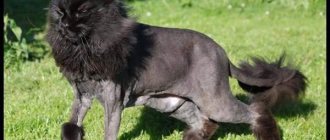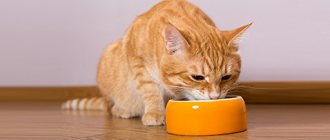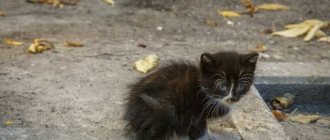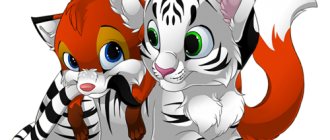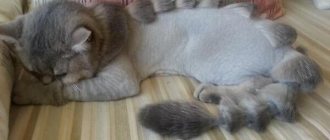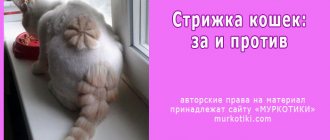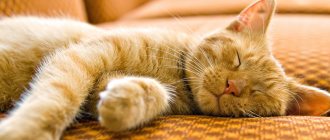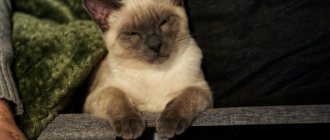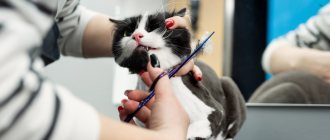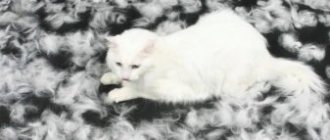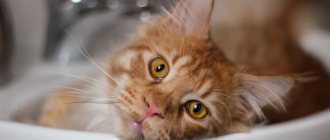Save the article:
Not everyone knows what cat grooming , although they are familiar with some pet care procedures. Grooming is an English term denoting cosmetic and hygienic procedures for caring for one’s appearance, including washing, cutting, treating nails and other actions.
In many English cities, grooming is a concept that applies to both people and animals. Not so long ago there was a profession of a groom - a groom, whose duties included caring for horses, and today there is a profession of a groomer. These are specialists who bring shine to pets.
Unfortunately, some owners consider caring for the appearance of their pets a privilege of exhibitions, but when was caring about hygiene and beauty superfluous?
Grooming and its types
The goals of grooming vary. Some owners prepare their dogs for an exhibition, others want their dog to be known as a “neat guy,” and still others want a creative and extraordinary appearance for their pet. Depending on the intent of the cosmetic procedures, there are several types of grooming:
- Hygienic.
- Home.
- Exhibition.
- Creative.
Hygienic. Includes a hygienic haircut (cutting hair in the groin and under the tail) once every 2 weeks - 1 month. It is advisable to do it before swimming. After trimming, it will be easier for the owner to care for the animal. In this case, a haircut along the body is not expected. This method of cutting hair is suitable for dogs in several situations:
- If the dogs belong to breeds that do not need a full haircut. These include both fluffy varieties: huskies, huskies, shepherds, and smooth-haired animals: Dobermans, Dalmatians, bull terriers.
- If the dog is not yet fully grown after the haircut, but needs light hygienic care. Some breeds undergo this procedure between haircuts to always remain well-groomed and look great. Such “dandies” include: poodles, Scotch terriers, Spitz, Pekingese.
- If the animal constantly participates in exhibitions. Accordingly, it requires regular hygienic care between haircuts. Most often this applies to breeds with full-length hair - Maltese, Shihtzu, Yorkie.
In addition to the “sanitary” haircut, hygienic grooming includes a set of standard procedures: cleaning the ears and removing excess hair from them, cleansing the eyes, teeth, trimming the nails. Much attention is paid to the paws. Excess hair is trimmed between the toes and pads, and the hair on the limbs is shortened in a circular manner.
Grooming and its types
Home grooming has one important feature. Its main goal is to give the dog a neat appearance, make it visually attractive and clean. In this case, it is not necessary to adhere to the breed’s conformation standards. A haircut is done more for the sake of hygiene and convenience, rather than for exhibition “beauty”.
Exhibition. But for this type of grooming, the entire procedure is performed strictly according to established rules. Moreover, when making an exhibition version, the master strives to maximally emphasize the advantages of the exterior, and, of course, tries to make the disadvantages of the four-legged appearance invisible. But all these manipulations are carried out in accordance with the requirements of the breed.
Creative. There are not and cannot be any rules, norms or restrictions. After all, when ordering such a service, the owner wants to give his dog’s exterior the most extravagant look. This is done mainly through original curly haircuts, when intricate patterns are cut on the animal’s fur.
There are other techniques through which groomers manage to turn even an ordinary dog into a work of art: dyeing the fur, adding decorative elements - rhinestones, feathers. Some experts are so keen on the creative option that they create dogs that look like pandas, dragons, dinosaurs and cartoon characters.
Tools and accessories
Even knowing that there are special salons, many people wonder how to cut a cat’s hair at home. In fact, without skill, it is better not to undertake the implementation of complex decorative designs and limit yourself to hygienic forms with minimal intervention. Otherwise, trying to trim a cat’s hair at home will result in serious injuries for all participants in the process.
Grooming cats in grooming salons is not complete without a cat clipper. They come in different capacities. For long-haired pets, as well as cats with thick undercoat, trimmers with a power of 45 watts or more are recommended. Other breeds can be trimmed with a less powerful clipper. Recommended wool length is 3 mm. Knife No. 3 is suitable for this. A regular trimmer is used in conjunction with a clipper to trim hard-to-reach areas.
You should not use a mechanical clipper to cut human hair. Despite the lack of noise and accessibility, you are unlikely to achieve symmetry and correct lines.
A must-have accessory is scissors. Preferably with rounded ends. To correct a cat's hairstyle at home, it is enough to buy regular ones, but in salons they also use thinning ones. They smooth out possible defects and provide the hairstyle with a finished look.
Before cutting, the fur must be thoroughly combed, so you can’t do without a brush; in addition, you will need it after cutting.
Stock up on hydrogen peroxide and cotton swabs, they will come in handy if something goes wrong.
Additional coat care
When working with color, to emphasize the dignity of the color, special means are used for lightening, bleaching, adding tint, etc. If there is a lack of color, special toning preparations are used, for maximum contrasts - optical amplifiers, for shine - serums and sprays, for volume and texture - special shampoos and lotions, for silkiness and smoothness - conditioners and masks.
Working with texture: all cats' fur should feel lively and mobile to the touch, not heavy, porous and cottony. The groomer's task is to achieve the “perfect coat”. There are many lines of care products for different types and different lengths of hair. It is important to remember that texturing wool is a very subtle and delicate aspect, although it has a general concept. Different rocks have different thickness, length, structure and volume, and the texture preparations used for each of them are different. Often on the packaging there is an inscription: “texturizing”, which in fact is a drug that gives density, elasticity, and in some cases rigidity. For example, such a drug will work great for a Siberian or Norwegian forest cat, but is completely unsuitable for cats with soft fur. And, on the contrary, preparations for the silky shiny soft coat of a Bengal cat are absolutely not suitable for a British cat, who will immediately lose his “crispy” crispy springy coat and volume. It is very important to select texture preparations for each specific cat in advance.
Prices for haircuts for cats in grooming salons in Ukraine and Russia
Russia (current prices in Moscow and St. Petersburg)
- Hygienic haircut – 1000-1500 rubles;
- Model haircut – from 1500 to 2500 rubles;
- Cutting patterns - the price is negotiated individually;
- Grooming at home - included in the cost of a haircut or plus 500 rubles;
- Additional payment for the aggressiveness of the animal - 500-1200 rubles.
- Haircut using anesthesia - from 1900 rubles.
Ukraine (how much does grooming cost in Kyiv)
- Hygienic cat grooming – from 200 hryvnia;
- Model haircut – from 300 hryvnia;
- Fantasy haircut, cutting of patterns - the price is negotiated separately depending on the complexity of the pattern;
- Grooming at home – 300 hryvnia;
- Haircut with anesthesia in the salon and at home – 350 hryvnia;
- Additional payment for cat aggressiveness is 50% of the cost of services.
How to cut a cat's hair?
| Miscellaneous |
Lately, pet grooming has become increasingly popular. Specialized hairdressing salons are opening, and specialists are appearing who work on call, coming to the home of the animal owner. As a rule, this type of care is required by long-haired animals, whose fur can cause inconvenience to both their owners and the animals themselves.
After all, long and thick hair gets into the animal’s stomach during licking and, clumping together, can cause nausea and even vomiting in the cat. In addition, thick hair can become a serious problem for your pupil on hot summer days and in winter if the temperature in the apartment is high. Many also cut cats simply for beauty, as well as to improve the appearance of animals before exhibitions - the so-called grooming.
If you do not plan to contact specialists, it is important to understand how to trim your cat without harming its health!
Grooming Before you begin the process of grooming an animal, be sure to trim the cat’s claws so that, having become agitated during the haircut process, she cannot harm you and herself, because grooming is very stressful for an animal!
How to trim a cat's claws In order to properly trim a cat's claws, it is best to use a special nail clipper, which can be purchased at any pet store. If you don’t have such a tool at hand, you can use sharp nail clippers, but in no case scissors, as they can damage the structure of the claw, causing it to delaminate and cause discomfort to the animal for a long time. It is necessary to cut the claw with such nippers perpendicular to it.
It is important not to shave the claws too short - an inexperienced person may cut the claw too short, thereby damaging the cat's finger. If you do cut your claw very short and blood appears on the claw, don’t be alarmed! Treat the wound with a disinfectant (for example, hydrogen peroxide) and within five minutes the bleeding will stop
How to trim a cat correctly After all the claws are trimmed, you can start cutting! Keep in mind that the cat will be very nervous and struggle, and you most likely will not be able to cut your cat’s hair alone, so I recommend that you find yourself an assistant. It is most convenient to groom a cat on a hard, flat surface, such as a table covered with thick cloth or a blanket. First, you should trim your back, sides and stomach, for which it is most convenient to use a hair clipper
After which you can start cutting your armpits and genital area, which should be done with special attention and caution! Paws can be cut no lower than the elbows and knees! When cutting around the pads on the paws, it is better to use scissors with blunt ends so that the cat does not accidentally get hurt! Under no circumstances should you cut your cat's head. It is allowed to trim the mane slightly, but nothing more! To cut a cat's hair short, it is allowed to use the clipper against the growth of the fur, but in this case the nozzle must be at least three millimeters in order to avoid damaging the pet's skin!
Types of haircuts for cats
The most common types of haircuts are: 1) Hygienic cat haircut (grooming). This procedure should be carried out with a certain regularity, since with its help:
- existing tangles on the wool are cut off (of course, a caring owner should under no circumstances allow them to occur),
- The overgrown hair near the cat's face, ears and private parts is removed.
2) Cosmetic haircut for grooming cats - is of an aesthetic nature and helps to bring the cat’s coat into an appropriate appearance.
- The overgrown hair all over the animal's body is trimmed and a specific hairstyle is created.
- The lion haircut for cats is very popular. In addition, a cosmetic haircut prevents large hair loss, which often occurs during the molting period.
3) Exhibition cat grooming. Many pets take part in cat shows. Therefore, on the eve of this event, there is a growing need to carry out a similar haircut that would meet the requirements existing at the exhibition and fall within the parameters of the standard of a certain breed.
4) Therapeutic cat haircut (grooming). This type of haircut is usually used for medical reasons, when it is necessary to gain access to the cat’s skin for any procedure.
Also, therapeutic grooming of long-haired cats often becomes an important procedure in the summer. This is due to the fact that when the air temperature is high in the summer, a cat can get heatstroke if its fur is long enough
A professional groomer gives a cat a haircut on a special table on which the pet is placed. The most common length of cut wool is 2 cm.
Grooming short-haired cats can be dangerous, since if you are careless, bringing the clipper close to the skin can injure the cat. If the pet reacts negatively to such a procedure, then special muzzles for cats and nail stickers can be used
This will protect you from cat bites and scratches. In some cases, these methods may not help, so in extreme cases, haircuts are performed under anesthesia.
Combing
To make the combing process go faster, you need to apply a special spray to the pet's fur to help comb it.
- In order to comb your pet you must have a special brush.
- There is also a special glove for grooming cats, which makes the combing process faster. It is convenient to cut hair with it.
- You hold your pet with one hand and comb it with the other. It should be combed in the direction of hair growth.
- The glove itself is made of fabric, and the part that combs is made of silicone with bristles. She doesn't just comb, she also massages the pet.
- Cats love this procedure. Doesn't hurt when combing.
Cats with long hair are brushed more often than cats with short hair. When cats are shedding, it is recommended to brush them every day.
Let's go to the grooming salon
When the owner of a furry purr does not have enough skills and opportunities to groom the animal on his own, a decision is made to change the image of the pet by the masters of the grooming salon.
Grooming experts will do the job efficiently and quickly, with minimal discomfort for the cat.
When deciding to take your pet to the cat barber, you should remember the following nuances:
- During the trip, the cat may become agitated and behave aggressively in the future;
- the cost of a haircut depends on the type of hairstyle - model ones are more expensive than hygienic ones (the latter cost from 1-1.5 thousand rubles);
- the result depends not only on the skill of the groomer, but also on the condition of the animal’s coat;
- If the master is unable to cope with a frightened pet, a sedative injection may be offered, which does not have the best effect on the health of the purr.
The best way to change the appearance of your pet is to call a grooming specialist to your home. After all, in a familiar environment, it will be easier for the animal to endure the grooming procedure with minimal stress. And a professional hairdresser will not harm the cat, delicately removing excess hair from the most difficult and sensitive areas.
Grooming includes not only shortening the coat - it is a whole range of procedures for caring for the appearance of the animal. This includes bathing, nail trimming, teeth and ear cleaning, as well as more exotic treatments such as spa services, manicures, and coat dyeing.
Reasons for the procedure
Hygienic grooming relieves long-haired cats from clogging their stomachs with lint during the molting period, and relieves owners from fluffy deposits on clothes and interior items. The growth and loss of fur in cats is a continuous process, but once or twice a year, when shedding begins, the fur falls out intensively. This is the only inconvenience associated with long-haired felines that hairdressing services can successfully solve.
The reasons for carrying out hygienic grooming in the salon or at home are the following reasons:
- Too voluminous and long hair in the summer or at high room temperatures contributes to overheating of the pet’s body.
- An aged animal cannot cope on its own with maintaining its coat in perfect condition.
- If there are pathologies of the gastrointestinal tract, then ingestion of a large number of hairs by a cat, especially during the molting period, can aggravate its health condition or negatively affect treatment.
- Increased secretion of substances of specific action (secrets) by the endocrine glands.
- Skin diseases, the treatment of which is hampered by long hair.
- Clumped and tangled pile, which is a symptom of various diseases.
- Mats and matted fur.
Pros of grooming:
- No wool deposits on upholstered furniture and clothing.
- It is easier to wash your pet and there is no need to dry it with a hairdryer.
- In summer, the cat does not languish from the heat.
The protests of cat owners who express a negative position regarding visiting pet hairdressing establishments are understandable. And they are based, first of all, on the fear of harming a defenseless creature. But you need to approach any event sensibly: if you eliminate all possible risks when carrying out grooming, then if the need arises, you can do a pet haircut.
Minuses:
- Stress for a pet that is unaccustomed to interference in its life from strangers.
- Possible abrasions on the cat’s body if hairdressing manipulations are performed by an unprofessional master.
- Undesirable consequences of using anesthesia in case of an allergic reaction.
Adviсe
Before deciding to groom your cat, you need to take into account the recommendations of experienced professionals. Thus, professional groomers advise, if possible, not to touch the tail, which is the most vulnerable part of the animal’s body.
Even minor damage to it causes enormous suffering to the pet and can negatively affect the cat’s overall well-being. You should also pay attention to the stomach, especially the lower, most tender part.
The next point that experts advise you to pay attention to is the psychological preparation of your pet. This procedure may require some time and patience from the cat owner.
So, long before the planned haircut, you need to start accustoming the animal to the table. This should be done very carefully and consistently.
To begin with, simply place the cat on the work surface, stroke its sides and back and, if possible, try to lay the pet on its side without stopping stroking. After the animal stops behaving warily on the table and responds happily to caresses, they carefully begin combing, each time increasing the time of the procedure.
If you are consistent and do not forget to regularly brush your cat on the table, then over time she will get used to the procedures and will perceive both the table and the comb quite calmly. The next important step will be to accustom your pet to the sound of a running machine. Ideally, it is better to purchase a silent device, but if this is not possible, then you can try to accustom the cat to the noise of a running electric motor. To do this, a few days before the haircut, you should turn on the clipper for a short time, while holding the pet in your arms and stroking it.
In general, grooming a cat should be perceived as an extremely last resort when the animal’s fur is hopelessly neglected and it is not possible to comb out the tangles. As for haircuts for decorative purposes, in this case it is necessary to be guided by the cat’s reaction to the procedure, while assessing the possible consequences. When performing complex show hairstyles, it is recommended to give the cat a rest and trim it in 2-3 stages.
It should also be remembered that a trimmed mustache, as well as hair inside the ears and on the head, significantly reduces the sensitivity of the smell receptors. There is no need to groom overly aggressive or overly active pets yourself. It is better to take such animals to an experienced groomer, where sedatives may be required. Thus, each owner must decide for himself whether to cut his pet’s hair or not. To do this, you need to soberly assess the benefit/harm ratio and focus primarily on the well-being and mental balance of your pet.
To learn why cats need to be groomed, watch the following video.
Express - shedding in dogs
What it is? The good old procedure of combing dogs, plus washing, plus blow-drying was called Express Shedding by someone else. Who needs it? Well, first of all, I would like to say - for dogs with a double coat type, such as Spitz, Chow Chow, etc. For dogs with medium length, for example, shepherd dogs, Pekingese, Akita Inu, Shiba Inu, it can also be carried out, especially in spring and autumn, when flakes of fluff begin to cover the floors of your shared home. But a HUGE WARNING - look for grooming salons where masters use classic combs and slickers to comb dogs, and in no case a mechanical machine called FURMINATOR. Watch a detailed video about its dangers on our YouTube channel. Let's say one thing - more and more often animals come to us after other masters, whose molting was carried out with a furminator, which caused cicatricial alopecia, as a result of which the hair does not grow in places for a year, exactly after some salons and schools , due to not understanding the problem, began using it for the combing procedure, which contradicts not only the manufacturer’s recommendations, but also basic common sense. Be vigilant and careful.
Creative grooming
If everything is clear with traditional types of grooming (pet, professional), then creative grooming deserves more attention.
This is a real art, which not every specialist masters, since, in addition to professional qualities, he must have considerable imagination and artistic talent.
Creative grooming, of course, sometimes goes beyond all limits. But here the master clearly tried to make the dog positive
The most popular ideas are cutting patterns and pictures on the pet's body, creating tattoos, pedicures, dyeing wool, piercings and decorative jewelry.
The prices for these services are quite high, but it is definitely worth it.
Cutting patterns occurs as follows:
- First, a pattern or picture is thought out. A true professional can complete almost any idea - from a popular foot to an entire painting.
- Next, special paints are applied to the skin.
- Trimming. Large pictures require a lot of time and effort.
Tattoos on the body of an animal look no less creative, although they are much easier to do. Transfers are simply applied to the prepared skin of the pet.
They are worn for about 3-4 weeks and are completely harmless to the dog’s health.
Golden “socks” on the paws, decoration on the neck and patterns in the form of leaves – what’s not to say about the autumn mood?
Dog pedicures are far from new in pet salons. For this purpose, special grooming cosmetics are used.
For example, the varnishes used to cover a dog’s claws do not contain solvents and are therefore safe for health.
And what? Bright colors are in fashion now
Piercing is a new procedure, but has questionable reviews.
After all, it would seem that ear piercing is harmless and is suitable for almost all breeds, but the animal can injure itself if the jewelry gets caught in a corner or some object.
The cheapest option is to use various decorations. The most common examples are bows, braids, and hairpins on Biewer Yorkies.
What to consider if you decide to trim your cat
Grooming is stressful for the animal, so it is best to refuse it unless there are clear indications (state of health, coat or exhibition). If necessary, ask the groomer about the possibility of sedation (use of anesthesia). Don't forget to check this with your veterinarian first and inquire about the groomer's medical background. It is best if a specialist from a grooming salon comes to trim your pet at home
This is especially important if the cat is nervous and does not like the grooming procedure. A familiar home environment has a calming effect on your pet. In some cats, after a haircut, the coat may change color and texture, for example, it becomes darker and thinner.
Keep this in mind and do not cut cats with color point and tipping colors. There are cases when an animal’s fur takes a very long time to grow back to its full length or does not grow back at all. Possible sudden color change. It is not recommended to cut the hair on the animal's head, whiskers and eyebrows - this can damage the whiskers. You cannot completely cut the hair from the tail - leave the hair at ⅓ of the length. Cats love to chew their tail, thereby causing wounds to themselves. In the area of the fingers and lower joint of the limbs, you need to leave “socks” made of wool. Their length may vary. Before grooming, a cat needs to trim its claws to avoid wounds and scratches not only for the owners and groomer, but also for the pet itself. The frequency of haircuts depends on the condition of the coat and the health of your pet; usually cats are cut 2-3 times a year. The ideal nozzle for a clipper used to cut a cat’s hair is 3 mm. When using it, the trimmed fur will be soft and will not cause discomfort to the cat. If you use a 1 mm nozzle, the fur will be prickly for the first week - pets don’t like this. It is unacceptable to shave cats' heads. They have very delicate skin. A hairless cat can injure itself simply by scratching itself. Animals that go outside can get sunburned. It is not recommended to remove tangles with scissors - this can injure the skin. To prevent this from happening, they cut it with a clipper or use a fine-tooth comb (comb) under the tangle, and only then carefully cut it off. Exhibition animals are allowed to be groomed 3-6 months before the exhibition.
Cases when it is undesirable
With all the advantages of a haircut, you should consider situations when it is better not to do it:
- The cat belongs to the short-haired breed.
- The animal lives or happens to be in cool places.
- There is often air conditioning in the room.
- The cat's fur does not need to be shortened.
- The kitten is still too small (under three months).
Also, experts do not recommend cutting the fur too short without good reason - its minimum length should be at least 3 mm.
What is meant by grooming and why is it needed?
Grooming refers to a whole range of activities necessary to care for an animal:
- Nail trimming.
- Combing wool, untangling matted areas.
- Grooming of domestic cats, especially long-haired breeds.
- Ear cleaning.
- Eye care.
- Trimming the fur between the fingers.
- Removing tartar and generally caring for your pet’s entire oral cavity.
- In some cases, grooming includes cleaning the anal and other glands.
The word comes from the ancient designation “groom” - a person whose profession was caring for an animal, primarily a horse. Nowadays, the term has passed on to any “hairdresser” for animals, and the professional himself is more often called a “groomer.”
Model haircut "French Lion"
Zoosalon Khvostovil (VAO)
Address:
- m. Kotelniki, st. Stroiteley, 2
- m. Reutov, Nosovikhinskoye sh., 27
Website: https://hvostovil.ru Phone: , Cost: from 1600 rub. per complex
Welcome to the City of Beautiful Animals “Khvostoville”!
Khvostovil is a chain of pet salons in the east of Moscow. Branches conveniently located near the Novokosino metro station and Kotelniki metro station invite you to professional grooming of dogs and cats.
Pet salons provide the following services:
- grooming dogs and cats,
- dog trimming,
- hair care for dogs and cats,
- trimming nails of dogs and cats,
- cleaning dogs' teeth with an ultrasonic scaler DTE (without anesthesia),
- rental of a special bath for self-washing large breed dogs.
You can find a complete list of services offered on the Services and Prices page.
The zoo grooming salon is equipped with everything necessary for professional and careful care of your dogs and cats. Serious attention is paid to the hygiene of workplaces and tools. All instruments and work surfaces are sterilized immediately before each haircut. The air in the room is disinfected by ultraviolet recirculators. The animal will not be hot; we have a spacious room with powerful air conditioning.
Popular cat hairstyles
Thanks to the imagination of the owner and the skill of the groomer, the external image of the pet can be radically changed. The following haircuts are popular in grooming salons: Lion, Dragon, Puss in Boots and others.
Leo is a fairly universal “hairstyle”. It can be used both for hygiene purposes and for exhibition purposes. This option is better to choose in hot weather. The next type is the dragon. This unusual haircut is characterized by the presence of an original mohawk along the back of the pet. With this “styling” option, only the fur on the body is cut off, while the head remains untouched. Along the length from the spine to the tail, the fur is cut in the shape of triangles. You can also leave scraps of wool and other elements. Here everything is limited by the hairdresser’s imagination.
Exhibition or model hairstyles should be created by experienced groomers; such work requires high professionalism. These hairstyles include: Harlequin, Modern and Continental. We can conclude that a haircut can simplify care and reduce the amount of hair loss, as well as make the pet’s appearance more interesting. But do not neglect the recommendations for the procedure.
But what to do if your pet stubbornly refuses to give in to the onslaught of the hairdresser? In this case, you will have to care for the fur as usual and not abuse the animal. You should periodically comb and remove matted hairs.
It is also better to resort to the use of additional care balms or shampoos that help soften the cat's hair. Nowadays, there are special products for long-haired breeds that dissolve mats in the stomach. To prevent your cat from experiencing heatstroke in the summer, it is worth purchasing an air conditioner.
For information on how to trim a cat's hair at home, see below.
Claw treatment
To trim cats' claws, you need to purchase special nail clippers. It is not recommended to use ordinary nail scissors, as they can damage the nail plate and cause it to break.
Claws should be trimmed only from above, to a length of no more than 1.5 mm.
If your pet is often outdoors, its paws should be regularly inspected for wounds, abrasions or splinters.
Also watch the video of salon cat grooming:
Why do you need to groom your pets?
There are many situations in which grooming cats is acceptable, if not vital. And we’re not just talking about going to a felinological competition. Very often, veterinarians advise resorting to grooming when they notice a problem with the animal’s fur or skin.
In this regard, all types of haircuts for cats can be divided into two:
- Model.
- Hygienic.
Model grooming is performed mainly for exhibitions and is a real work of art.
A completely different matter is cutting the fur, which is necessary to maintain the health of the pet. Hygienic cat grooming has a more familiar look and is easy to perform:
- Most often, it is done to avoid matting of long hair or to remove formed tangles that cause pain to the cat.
- Cats actively lick themselves and can either injure themselves trying to gnaw out the mat, or eat a lot of hair, which rolls into lumps in the stomach and can cause intestinal obstruction.
- The veterinarian may prescribe a haircut in case of skin diseases or parasites.
- Some animals have a problem such as feces sticking to the long hair near the hind legs and tail. In this case, you don’t have to cut the whole animal, but just shorten the “pants” a little.
- Many cats with long or semi-long hair undergo grooming in the summer heat to protect them from overheating. This is especially necessary for Siberian cats, Persian cats, Norwegian forest cats and others accustomed to colder climates.
- It also happens that an old or sick animal cannot care for its fur on its own. In this case, a haircut helps him stay clean and look decent.
Model haircut "Dragon"
Types of exhibition haircuts
Model cat grooming can be done not only for a trip to an exhibition. Many owners regularly visit the salon to give their pet an original look. Each hairstyle is individual. And yet, there are several of the most popular varieties, on the basis of which groomers create their exclusive works of hairdressing art.
- "French Lion" For this hairstyle, the back, top of the paws and base of the tail are completely trimmed. The head and neck fur remain intact, giving the impression of a luxurious mane. The tip of the tail is not cut either. A specialist can give it the shape of a lion tassel, a pompom, a stepped herringbone or a neat whisk. Sometimes the fur is shortened just a little, resulting in a fluffy squirrel tail. The length of the “socks” and “gloves” on the paws can also vary. Thus, a unique image of the animal is created.
- "Puma." This haircut is done in almost the same way as the “Lion” option, but in addition the fluffy shirtfront on the chest is preserved.
- For the “Dragon” model, the sides and belly are cut smooth, while the hair along the ridge and tail remains untouched. It is only given the shape of a carved comb with sharp teeth.
- “Puss in Boots” fully corresponds to its name: the fur on the animal’s back is shortened, and the upper part of its paws is cut off to make neat boots.
There are also more intricate haircuts - such as “Modern”, “Continental”, “Harlequin”. All of them are performed only by specialists.
Model haircut "Puss in Boots"
Varieties
Cat haircuts are divided into two groups: model and hygienic. The latter pursue very specific goals and are carried out in order to protect the animal from overheating and tangles, as well as for veterinary indications. These include diseases of the skin and gastrointestinal tract, increased secretory activity of the sebaceous and para-anal glands, as well as the senility of the pet, when it is no longer able to cope with its fur on its own.
Model haircuts are performed exclusively for decorative purposes to make the animal more attractive, as well as before cat shows. The most common of them are haircuts like a lion, like a dragon, and like a dinosaur. The puma hairstyle is also very popular and is a simplified version of the lion haircut. The only difference is the design of the tail: for example, if in a “puma” it is cut almost bald, then in a “lion” it repeats the shape of a real lion’s tail with a fluffy tassel.
However, the most creative can be called the “dragon” haircut, which includes various variations of cutting symbols, letters, ornaments and figures on the back of the animal. Despite the rather exotic appearance of the pet, most veterinarians warn owners against performing this haircut. This is due to the fact that after cutting the patterns, the fur on the pet’s skin becomes uneven, which greatly disrupts thermoregulation and does not allow the body to adapt to this type of heat transfer.
A graduated hairstyle has a much stronger negative impact on the cat’s condition than uniform haircuts, to which the body adapts over time. The same, but to a slightly lesser extent, applies to the “socks”, “sock socks” and “puss in boots” haircuts, which are also very popular among cat owners. Among exhibition haircuts, “harlequin”, “modern” and “continental chic” are very popular.

